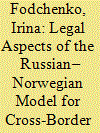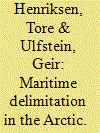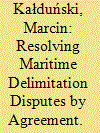|
|
|
Sort Order |
|
|
|
Items / Page
|
|
|
|
|
|
|
| Srl | Item |
| 1 |
ID:
084987


|
|
|
|
|
| Publication |
2008.
|
| Summary/Abstract |
In 1945 Stephen B Jones, an American political geographer, published Boundary-Making: A Handbook for Statesmen, Treaty Editors and Boundary Commissioners in which he set out the practicalities of boundary delimitation, demarcation and maintenance. The significance of this volume to boundary scholars and practitioners cannot be overstated. Jones's book, outlining guidelines for good practice in boundary-making, continues to be consulted as a unique work of its kind. However, now over sixty years since publication, its age is starting to tell. The recent decision of the Eritrea-Ethiopia Boundary Commission (EEBC) reveals how some of the core concepts of Boundary-Making are being re-interpreted and some of the practices espoused by Jones may be in need of updating to encompass the changes in boundary-making during the last half century. Framing the discourse around the EEBC's notion of boundary 'demarcation', we examine the context in which Jones wrote his book, consider why it has become such an important work, and suggest how it can continue to be relevant for twenty-first-century boundary practitioners.
|
|
|
|
|
|
|
|
|
|
|
|
|
|
|
|
| 2 |
ID:
160924


|
|
|
|
|
| Summary/Abstract |
This article examines the provisions in the 2010 Russian–Norwegian Treaty on Maritime Delimitation and Cooperation in the Barents Sea and the Arctic Ocean dealing with the management of transboundary hydrocarbon resources. How compatible is the unitization mechanism in the Treaty with Russian and Norwegian legislation? Will there be tension between Russian and Norwegian interpretations? How does Russian and Norwegian legislation support or challenge the concept of a “unit operator” in a cross-border unitization? What are the possible concerns and pitfalls related to mechanisms for consultations and procedures for dispute resolution?
|
|
|
|
|
|
|
|
|
|
|
|
|
|
|
|
| 3 |
ID:
104170


|
|
|
|
|
| Publication |
2011.
|
| Summary/Abstract |
During a visit to Norway by the Russian president in the spring of 2010, the president and the Norwegian prime minister surprisingly announced agreement on a delimitation line in the Barents Sea ending almost 40 years of negotiations. The agreement was signed in Murmansk on 15 September 2010. This article presents the background of the dispute and undertakes an assessment of the agreement and its implications for the Barents Sea, Svalbard, and other Arctic maritime delimitations.
|
|
|
|
|
|
|
|
|
|
|
|
|
|
|
|
| 4 |
ID:
165685


|
|
|
|
|
| Summary/Abstract |
The presence of third States occurs when two countries delimit their maritime boundary in a maritime area where there are more than two coastal States. The bilateral nature of maritime delimitation between two States requires the delimitation process not to prejudice the legal rights and interests of third States. On the one hand, at the procedural stage of international adjudication, third States may file an application for permission to intervene in the proceedings before a court or tribunal; at the merits stage, a third-party judicial organ may leave undecided the endpoint of a final boundary line to be delimited, so as not to affect the rights of a third State. On the other hand, in interstate maritime boundary agreements through international negotiation, in order to take care of third States’ legal rights and interests, States may adopt several ways of addressing the existence of tripoints. This paper, in four parts, discusses the presence of third States in international maritime boundary delimitation. The first part gives a definition of a third State in the framework of maritime delimitation. The second part reflects on international adjudication relating to the presence of third States. The third part provides some observations on State practices relating to the existence of tripoints. The conclusion points out that there is a widening gap between maritime delimitation in theory and in practice, since recent case law particularly confines the delimitation to a purely bilateral status, without enough focus on the presence of third States, resulting in procedurally prejudicial impacts upon the legal rights and interests of third States.
|
|
|
|
|
|
|
|
|
|
|
|
|
|
|
|
| 5 |
ID:
173427


|
|
|
|
|
| Summary/Abstract |
It is clear from the plain words of the Article 76, paragraph 10, of the UN Convention on the Law of the Sea that the questions involving the outer limits of the continental shelf beyond 200 nautical miles are without prejudice to the question of delimitation of the continental shelf between states with opposite or adjacent coasts. However, the two processes impact each other, which gives rise to more complex dynamics than may be perceived from a cursory reading of Article 76. This article explores the relationship between the two separate but inherently related processes in light of the relevant jurisprudence and doctrinal commentaries thereto.
|
|
|
|
|
|
|
|
|
|
|
|
|
|
|
|
| 6 |
ID:
187410


|
|
|
|
|
| Summary/Abstract |
The extension of coastal states’ jurisdiction over seas in the twentieth century significantly increased the maritime area of overlapping entitlements. The Baltic Sea is a textbook example of such competing claims. In principle, the two main avenues for a coastal state to resolve its dispute are to either conclude a delimitation agreement or lodge the case with an international court or tribunal. This article analyzes the Delimitation Agreement between Denmark and Poland concerning the Baltic Sea south of the island of Bornholm. The states were divided as to how to apportion the maritime zone of 3,500 km2, where the economic zones of Denmark and Poland had not been delimited for several dozen years. The agreed single maritime boundary split the disputed area into unequal parts. The settlement of the maritime dispute coincided temporally with Poland and Denmark’s plans to build a natural gas pipeline at the bottom of the Baltic Sea, which probably prompted the two states to put an end to their maritime boundary dispute. The law of the sea provides that the delimitation of maritime zones between states with opposite or adjacent coasts is effected by agreement on the basis of international law in order to achieve an equitable solution. The purpose of this article is to show that (energy) security issues may prompt a resolution of a maritime boundary dispute, and to analyze the Polish–Danish Agreement in the light of the principles governing the maritime delimitation.
|
|
|
|
|
|
|
|
|
|
|
|
|
|
|
|
|
|
|
|
|